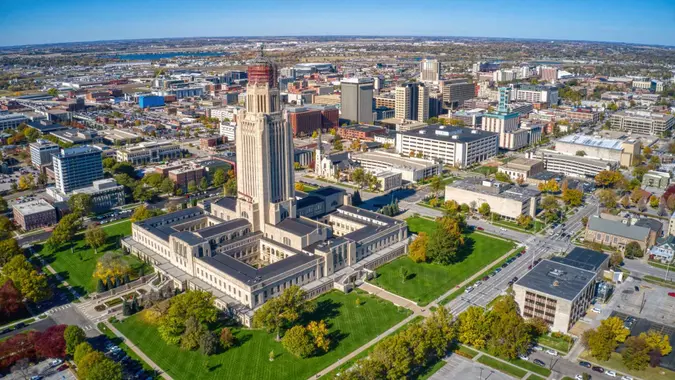14 Places To Retire That Are Similar to New York but Way Cheaper

Commitment to Our Readers
GOBankingRates' editorial team is committed to bringing you unbiased reviews and information. We use data-driven methodologies to evaluate financial products and services - our reviews and ratings are not influenced by advertisers. You can read more about our editorial guidelines and our products and services review methodology.

20 Years
Helping You Live Richer

Reviewed
by Experts

Trusted by
Millions of Readers
New York City might be the town that is so nice that they named it twice, but there’s nothing nice about the cost of living there. Look at any list of most expensive cities in the United States, and the Big Apple ranks at or near the top. That makes it an especially tough place to retire unless you are wealthy or have some other financial advantage, such as a home you bought for a song many decades ago.
A recent U.S. News Real Estate study found that New York is the fifth-most expensive U.S. city based on the median gross rent for renters and annual housing costs for mortgage-paying homeowners. According to that study, the median home price in New York City is $834,096 and the median monthly rent is $1,852. But you can expect to pay a whole lot more than that if you venture into some of the pricier neighborhoods in Manhattan or Brooklyn.
Housing costs only tell part of the story, however. Prices for almost everything are higher in New York City than in most other places, from utilities and groceries to dining out and healthcare. According to a new analysis from MoneyGeek, New York has far and away the highest cost of living index among the 35 biggest U.S. cities.
The cost of living index compares the living costs of different cities, based on a national median of 100. New York’s index came in at a whopping 221.4 – more than double the national median. To put that number in context, the second most expensive city, San Francisco, had an index of 170.8.
The good news is, you don’t have to live in pricey burgs like New York (or San Francisco) to enjoy big-city amenities in retirement. The U.S. is home to plenty of big cities with thriving downtowns, rich cultural options, major league sports and excellent cuisine – at much cheaper prices.
Below are 14 cities to retire in that are similar but much cheaper, based on metrics provided by MoneyGeek. All cities have a cost of living index below the national median (listed alphabetically).
Austin, Texas
- Population (within city limits): 912,791
- Cost of Living Index: 95
Charlotte, NC
- Population (within city limits): 809,958
- Cost of Living Index: 95.7
Columbus, Ohio
- Population (within city limits): 835,957
- Cost of Living Index: 89.7
Dallas, Texas
- Population (within city limits): 1,281,047
- Cost of Living Index: 95.9
Detroit, Michigan
- Population (within city limits): 680,250
- Cost of Living Index: 95.1
Houston, Texas
- Population (within city limits): 2,239,558
- Cost of Living Index: 98.5
Indianapolis, Indiana
- Population (within city limits): 848,788
- Cost of Living Index: 91.9
Jacksonville, Florida
- Population (within city limits): 853,382
- Cost of Living Index: 98.8
Louisville, Kentucky
- Population (within city limits): 612,780
- Cost of Living Index: 92.4
Memphis, Tennessee
- Population (within city limits): 656,861
- Cost of Living Index: 85.7
Nashville, Tennessee
- Population (within city limits): 644,014
- Cost of Living Index: 92.7
Oklahoma City, Oklahoma
- Population (within city limits): 620,602
- Cost of Living Index: 89.6
Phoenix, Arizona
- Population (within city limits): 1,537,058
- Cost of Living Index: 95.3
San Antonio, Texas
- Population (within city limits): 1,436,697
- Cost of Living Index: 89.7
More From GOBankingRates
 Written by
Written by  Edited by
Edited by 

























